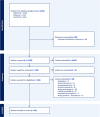Creativity research in medicine and nursing: A scoping review
- PMID: 39775257
- PMCID: PMC11709234
- DOI: 10.1371/journal.pone.0317209
Creativity research in medicine and nursing: A scoping review
Abstract
Background: Creativity fuels societal progress and innovation, particularly in the field of medicine. The scientific study of creativity in medicine is critical to understanding how creativity contributes to medical practice, processes, and outcomes. An appraisal of the current scientific literature on the topic, and its gaps, will expand our understanding of how creativity and medicine interact, and guide future research.
Objectives: We aimed to assess the quantity, trends, distribution, and methodological features of the peer-reviewed on creativity in medicine.
Methods: We searched the MEDLINE, EMBASE, and PsycINFO databases for peer-reviewed primary research publications on creativity in medicine. Screening, full-text review, and data extraction were performed independently and in duplicate by pairs of reviewers, with discrepancies resolved by a third reviewer. We performed descriptive analyses, graphically displaying the data using charts and maps where appropriate.
Results: Eighty-one studies were eligible for review, enrolling a total of 18,221 physicians, nurses and midwifes across all studies. Most research on creativity in medicine was published in the last decade, predominately in the field of nursing (75%). Researchers from Taiwan (22%) and the United States (21%) produced the most eligible publications, and the majority research was cross-sectional in nature (54%). There was substantial variability in the definitions of creativity adopted, and most studies failed to specify a definition of creativity. Forty-five different measurement tools were used to assess creativity, the most popular being divergent thinking tests such as the Torrance Test of Creative Thinking (24%) and Guilford Creativity Tests (16%).
Conclusions: Peer-reviewed scientific research on creativity in medicine, mostly conducted in the nursing profession, is sparse and performed on variable methodological grounds. Further scientific research on the topic, as well as the development of medicine-specific definitions and measurement tools, is required to uncover the utility of creativity in the medical domain.
Copyright: © 2025 Thabane et al. This is an open access article distributed under the terms of the Creative Commons Attribution License, which permits unrestricted use, distribution, and reproduction in any medium, provided the original author and source are credited.
Conflict of interest statement
The authors have declared that no competing interests related to this work.
Figures
Similar articles
-
Beyond the black stump: rapid reviews of health research issues affecting regional, rural and remote Australia.Med J Aust. 2020 Dec;213 Suppl 11:S3-S32.e1. doi: 10.5694/mja2.50881. Med J Aust. 2020. PMID: 33314144
-
[The application of creative thinking teaching in nursing education].Hu Li Za Zhi. 2010 Apr;57(2):93-8. Hu Li Za Zhi. 2010. PMID: 20401872 Chinese.
-
The effectiveness of teaching strategies for creativity in a nursing concepts teaching protocol on the creative thinking of two-year RN-BSN students.J Nurs Res. 2002 Jun;10(2):105-12. doi: 10.1097/01.jnr.0000347589.98025.63. J Nurs Res. 2002. PMID: 12119595
-
Bringing us back to our creative senses: Fostering creativity in graduate-level nursing education: A literary review.Nurse Educ Today. 2016 Oct;45:51-4. doi: 10.1016/j.nedt.2016.06.016. Epub 2016 Jun 23. Nurse Educ Today. 2016. PMID: 27429404 Review.
-
An integrative review: Developing and measuring creativity in nursing.Nurse Educ Today. 2018 Mar;62:1-8. doi: 10.1016/j.nedt.2017.12.011. Epub 2017 Dec 13. Nurse Educ Today. 2018. PMID: 29274494 Review.
Cited by
-
Creativity and job satisfaction among nurses in iran: a descriptive-correlational study.BMC Nurs. 2025 Jul 1;24(1):800. doi: 10.1186/s12912-025-03446-6. BMC Nurs. 2025. PMID: 40597231 Free PMC article.
References
-
- Runco MA, Jaeger GJ. The Standard Definition of Creativity. Creativity Research Journal. 2012;24(1):92–6. doi: 10.1080/10400419.2012.650092 - DOI
-
- Amabile T. Componential theory of creativity: Harvard Business School Boston, MA; 2011.
-
- Sternberg RJ, Lubart TI. An Investment Theory of Creativity and Its Development. Human Development. 1991;34(1):1–31.
-
- Baer J, Kaufman JC. Bridging generality and specificity: The amusement park theoretical (APT) model of creativity. Roeper Review. 2005;27(3):158–63. doi: 10.1080/02783190509554310 - DOI
Publication types
MeSH terms
LinkOut - more resources
Full Text Sources





